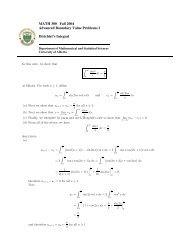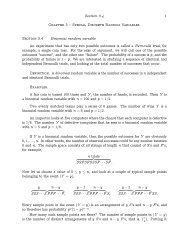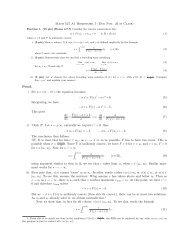Math 411: Honours Complex Variables - University of Alberta
Math 411: Honours Complex Variables - University of Alberta
Math 411: Honours Complex Variables - University of Alberta
You also want an ePaper? Increase the reach of your titles
YUMPU automatically turns print PDFs into web optimized ePapers that Google loves.
108 CHAPTER 16. MONTEL’S THEOREM<br />
• (fn,k+1) ∞ n=1 is a subsequence <strong>of</strong> (fn,k) ∞ n=1 , and<br />
• (fn,k(xk)) ∞ n=1 converges.<br />
For n ∈ N, set gn := fn,n. Then (gn) ∞ n=1 is a subsequence <strong>of</strong> (fn) ∞ n=1, and<br />
(gn(xk)) ∞ n=1 converges for each k ∈ N.<br />
We show that (gn) ∞ n=1 is a uniform Cauchy sequence on K (and thus convergent).<br />
Let ǫ > 0. Choose δ > 0 such that |f(x) − f(y)|< ǫ<br />
for all f ∈ F and for all<br />
3<br />
x,y ∈ K with |x−y|< δ. Since K is compact, there exist y1,...,yν ∈ K such that<br />
K ⊂ �ν j=1Bδ (yj). Since {x1,x2,x3,...} is dense in K, there exist k1,...,kν ∈ N such<br />
2<br />
that xkj ∈ Bδ(yj).<br />
It follows that K ⊂<br />
2<br />
�ν Bδ(xkj j=1 ).<br />
By construction, (gn(xk)) ∞ n=1 is a Cauchy sequence for each k ∈ N. Choose N ∈ N<br />
such that<br />
ǫ<br />
|gn(xkj )−gm(xkj )|<<br />
3<br />
for n,m ≥ N and j = 1,...,ν. Let x ∈ K be arbitrary, and let n,m ≥ N. Choose<br />
j ∈ {1,...,ν} such that x ∈ Bδ(xkj ), and note that<br />
|gn(x)−gm(x)|≤ |gn(x)−gn(xkj )| +|gn(xkj )−gm(xkj )|<br />
Hence, (gn) ∞ n=1<br />
� �� �<br />
< ǫ<br />
3<br />
� �� �<br />
< ǫ<br />
3<br />
is a uniform Cauchy sequence on K.<br />
+|gm(xkj )−gm(x)|<br />
� �� �<br />
< ǫ<br />
< ǫ.<br />
3<br />
Proposition 16.1. Let D ⊂ R N be open, and let F be a family <strong>of</strong> functions from D<br />
to R M that is equicontinuous and uniformly bounded on compact subsets <strong>of</strong> D. Then<br />
every sequence in F has a compactly convergent subsequence.<br />
Pro<strong>of</strong>. For each k ∈ N, define Kk := Bk[0] if D = R N and Kk := Bk[0] ∩{x ∈ D :<br />
dist(x,∂D) ≥ 1<br />
k } if D �= RN . Notice that<br />
• � ∞<br />
k=1 Kk = D and<br />
• Kk ⊂ intKk+1 for n ∈ N.<br />
Let (fn) ∞ n=1 be a sequence in F. By the Arzelà–Ascoli Theorem, there exists a<br />
subsequence (fn,1) ∞ n=1 <strong>of</strong> (fn) ∞ n=1 and a function g1: K1 → RM such that fn,1|K1→ g1<br />
uniformlyonK1. Invoking theArzelà–AscoliTheoremagain,weobtainasubsequence<br />
(fn,2) ∞ n=1 <strong>of</strong> (fn,1) ∞ n=1 and a function g2: K2 → RM such that fn,2|K2→ g2 uniformly<br />
on K2. Inductively, we thus obtain, for each k ∈ N, a subsequence (fn,k) ∞ n=1 <strong>of</strong> (fn) ∞ n=1<br />
and a function gk: Kk → RM such that, for each k ∈ N,<br />
• (fn,k+1) ∞ n=1 is a subsequence <strong>of</strong> (fn,k) ∞ n=1 , and<br />
• fn,k|Kk → gk uniformly on Kk.







